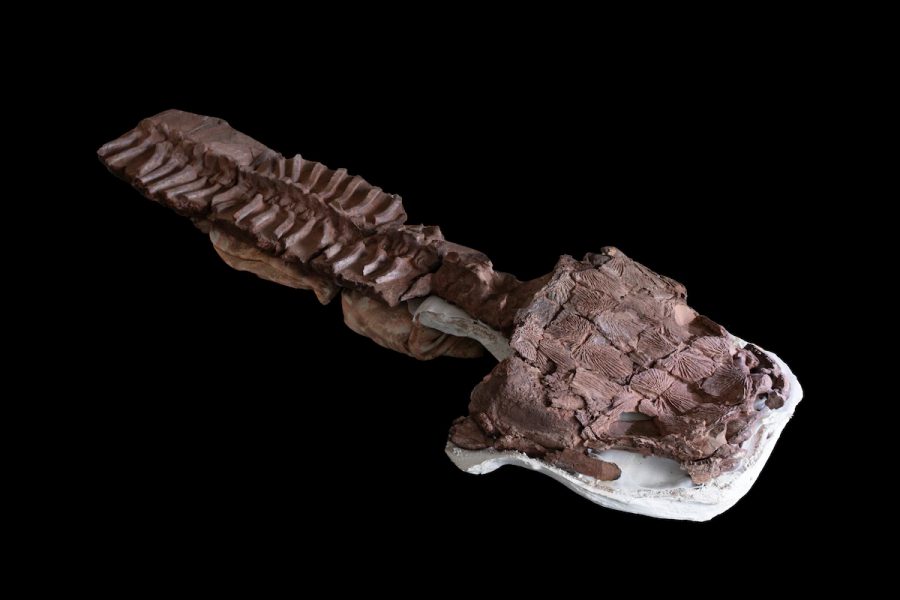Tue 16 July 2024:
An international team of researchers finally found a fossilised skeleton of a giant basal tetrapod in the arid region of Namibia after three years of research.
Basal tetrapods were four-legged vertebrates which existed when the predators made the crucial transition from water to land.
 Artist/illustrator Gabriel Lio’s reconstruction of Gaiasia jennyae, the new stem tetrapod from Namibia, and an apex predator of the wetland areas of southern Gondwana approximately 280 million years ago.
Artist/illustrator Gabriel Lio’s reconstruction of Gaiasia jennyae, the new stem tetrapod from Namibia, and an apex predator of the wetland areas of southern Gondwana approximately 280 million years ago.
The researchers have now found the three-metre-long skeleton in the Ugab River valley which is the largest one ever discovered. Its discovery has also jeopardised the theory that early vertebrates existed only in the northern hemisphere.
The skeleton’s discovery gave scientists insight into the terrestrial animals’ early evolution.
 Reattaching the loose pieces from a giant stem tetrapod fossil at the site of discovery in Namibia. From left to right Claudia Marsicano, Sibusiso Mtungata, Leandro Gaetano. Image credit: Roger Smith.
Reattaching the loose pieces from a giant stem tetrapod fossil at the site of discovery in Namibia. From left to right Claudia Marsicano, Sibusiso Mtungata, Leandro Gaetano. Image credit: Roger Smith.
A nearly complete skeleton leaves scientists amazed
The team was surveying the rugged terrain during the fieldwork in Namibia when they made the significant discovery.
In a statement, study co-author Roger Smith said, “The nearly complete skeleton was preserved in mudstone from an ancient freshwater lake. As the soft tissue decomposed, gasses formed that caused calcium carbonate to crystallize around the bones, creating a hard crust that protected them from being crushed as they were buried deeper.”
Meanwhile, Iziko Museum’s skilled fossil technician, Sibusiso Mtungata, remembered how the discovery was made.
 Claudia Marsicano pondering over the identity of a giant 280-million-year-old stem tetrapod skeleton at the site of discovery in the Ugab River valley of central Namibia. Image credit: Roger Smith
Claudia Marsicano pondering over the identity of a giant 280-million-year-old stem tetrapod skeleton at the site of discovery in the Ugab River valley of central Namibia. Image credit: Roger Smith
“We had found isolated vertebrae of something big, so we were looking for a more complete skeleton. I came across two round cylinders of rock with bone in the middle, which fitted together – and then a third. I called Roger over to help me find more, and as we walked upslope, he spotted a large flat rock, which he recognised as the head,” said Mtungata.
He added, “When we looked along the edge and saw rows of teeth, we knew we had finally found what we had been searching for – a nearly complete skull and skeleton!”
 Roger Smith and Sibusiso Mtungata who together recovered the skull and most of the skeleton of what is now the type specimen of Gaiasia jennyae. Image credit: Leandro Gaetano
Roger Smith and Sibusiso Mtungata who together recovered the skull and most of the skeleton of what is now the type specimen of Gaiasia jennyae. Image credit: Leandro Gaetano
Basal tetrapod with large interlocking fangs
Palaeontologist at the University of Buenos Aires, Argentina and lead author Claudia Marsicano said that she knew it was different from other species.
 Claudia Marsicano studying the prepared stem-tetrapod fossil in Cape Town before it was transported back to Namibia. Image credit: Roger Smith.
Claudia Marsicano studying the prepared stem-tetrapod fossil in Cape Town before it was transported back to Namibia. Image credit: Roger Smith.
“As soon as I saw this enormous animal, I knew it was a different species. There is no record of giant basal tetrapods during the Carboniferous-Permian transition (approximately 299 million years ago) anywhere in the world, and certainly none from the southern continents that made up Gondwana,” Marsicano said.
 Sibusiso Mtungata in Iziko Karoo Palaeontology Laboratory, using an air scribe to remove the surrounding rock and expose the fossil skull bones to sunlight for the first time since they were buried 280million years ago. Image credit: Roger Smith
Sibusiso Mtungata in Iziko Karoo Palaeontology Laboratory, using an air scribe to remove the surrounding rock and expose the fossil skull bones to sunlight for the first time since they were buried 280million years ago. Image credit: Roger Smith
“What caught my attention next was the structure of the front part of the skull, which was sticking out of the ground. It showed unusually large interlocking fangs,” she added.
The scientists suggested that it was an ambush predator who was feeding on fish which lived in the same lake.
SOURCE: INDEPENDENT PRESS AND NEWS AGENCIES
__________________________________________________________________________

https://whatsapp.com/channel/0029VaAtNxX8fewmiFmN7N22
______________________________________________________________
FOLLOW INDEPENDENT PRESS:
WhatsApp CHANNEL
https://whatsapp.com/channel/0029VaAtNxX8fewmiFmN7N22
![]()
TWITTER (CLICK HERE)
https://twitter.com/IpIndependent
FACEBOOK (CLICK HERE)
https://web.facebook.com/ipindependent
YOUTUBE (CLICK HERE)
https://www.youtube.com/@ipindependent
Think your friends would be interested? Share this story!





